
Common pests in your indoor garden
Learning to identify common pests that can attack our indoor garden can help prevent large infestations.
Common Pests
One advantage to growing indoors is that pests are less likely to find your garden. Most often, pests will be brought into your classroom through other plants or in potting soil, especially if it has been stored outdoors. Inspect plants before bringing into your home. Once a pest has established in your garden, it can be harder to eradicate without the presence of natural predators. Remember, placing sticky traps in your garden immediately upon planting is a great warning bell to let you know a pest has arrived. Act on pest issues right away!
Always remove dead, weakened and infected plant matter from around the plant.
Best practice methods for getting rid of pests
The sight of a pest is enough to make gardeners reach for a chemical to take care of it. Growing indoors though means that we need to be more cautious with the use of chemicals as we do not want to be breathing them in in our confined spaces.
There are alternatives to chemical treatment of pests but you should prepare for repeated treatment of pests. Each method of controlling garden pests typically targets a particular stage in the pest’s life cycle. For example, if your method targets the adult pest, you will need to keep applying the treatment until all of the existing eggs have matured into adults.
Squish pests or dab with rubbing alcohol
EFFECTIVE CONTROL METHOD FOR: MEALY BUGS AND APHIDS
If your infestation of aphids or mealybugs is small, you may be able to simply squish them, or dab the bugs with a cotton swab dipped in rubbing alcohol. Be sure to wipe off the eggs from the underside of leaves.
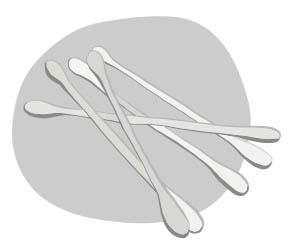
Vacuum pests away
EFFECTIVE CONTROL METHOD FOR: MEALY BUGS, APHIDS, WHITEFLIES, APHIDS, FUNGUS GNATS, THRIPS AND SPIDER MITES
This method is quick and straightforward and can control whiteflies at all stages of growth, as well as other pests on your plants. Be careful not to damage the plant. Simply use your handheld vacuum or vacuum cleaner hose attachment to suck up pests every few days. Make sure that any newly hatched pests can't escape from your vacuum bag. Seal the bag when finished and leave in your freezer if available for 24 hours.

Sticky traps
EFFECTIVE CONTROL METHOD FOR: APHIDS, WHITEFLIES, THRIPS, FUNGUS GNATS.
Sticky traps are also your best warning sign of a pest issue and should be placed in your garden immediately upon planting your Earthboxes/GrowBoxes. You can purchase sticky tape from garden stores or make your own with yellow cardboard/construction paper and petroleum jelly. The colour yellow looks like a mass of new foliage for pests. The bugs are attracted to the paper, get stuck in the jelly, and die. Simply coat your yellow card or paper surface with petroleum jelly and place in your garden. Tape or clip the cards to a chopstick or skewer and stick into soil.

Remove bugs manually by hand or with cloth or paper towel.
EFFECTIVE CONTROL METHOD FOR: APHIDS, MEALY BUGS AND SPIDER MITES.
This is the simplest form of control. You can pick aphids or mealy bugs off your plants by hand. You can also wipe foliage with a damp cloth or paper towel. Immediately wash out rags. If you are using paper towels, place used towels in a plastic sack and discard. Lastly, you can try placing Scotch tape against infected plant material and then peel it off (with aphids attached).
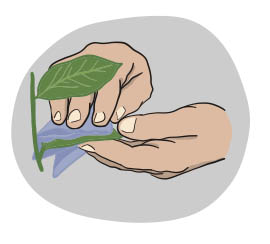
Trim infested or damaged leaves
THIS METHOD CAN BE DONE FOR ALL PEST INFESTATIONS
If your plant is heavily infested, you will want to trim as much as you can without injuring the plant. This will help get the infestation under control faster by eliminating many of the nymphs and eggs. Make sure to properly dispose of the diseased leaves by burning them or sealing them into an airtight bag and throwing in the garbage. Trim only as much damaged leaves as there is healthy leaves. If the plant is beyond salvage, you’ll want to dispose of your plant as quickly as possible to stop the spread of the infestation.

Insecticidal soap
EFFECTIVE CONTROL METHOD FOR: MEALY BUGS, APHIDS, WHITEFLIES, FUNGUS GNATS.
MODERATELY EFFECTIVE FOR: SPIDER MITES AND THRIPS
This solution sounds menacing, but it is very safe for a home and for food plants. It is the oil in the spray which controls the pests. You can make your own soap treatment by using dish soap and vegetable oil or pure castile soap (which already has oil in it). Try to find a product free of perfumes and additives that could harm plants. Mix the soap in a weak concentration with water (1 teaspoon dish soap/vegetable oil or 1 teaspoon of pure castile soap per litre of water and increas- ing concentration as necessary). Spray on plants and pay special attention to the undersides of the leaves, where pests will live. Be aware that this method only kills the adult insect. Apply every 3-4 days until infestation is gone. Please find full directions to use insecticidal soap at the end of this chapter.
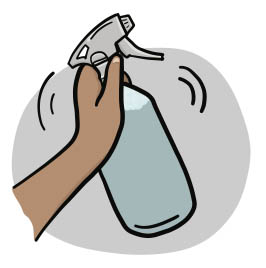
Aphids
What they look like
Aphids, also known as plant lice, come in different colors like gray, black and green. They cluster on the underside of leaves and suck the sap from them. They can be found anywhere on the plant, but often congregate along its stems. Like whiteflies, they excrete a sticky substance referred to as "honeydew," in which black sooty mold grows.
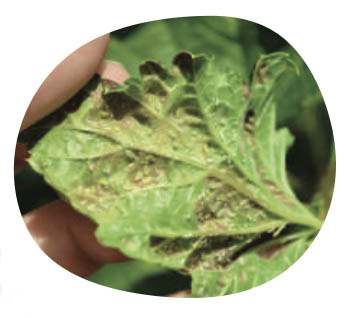
Symptoms
Leaves develop yellow spots, then wilt. Black mold growing on top of leaves. Aphids weaken plants by sucking the juices out of their leaves and turning them yellow.
Control
Use an insecticidal soap spray made from dish soap, water and vegetable oil. Be sure to target the pests on the bottom of leaves, too. Aphids produce as many as 12 new offspring per day. You will need to use two-three applications of soap spray. Once now, and once in 3 days and then 5-7 days to get the next generation.
Prevention
Use sticky traps and check daily for signs of pests. Check underneath leaves every week to catch any new infestations.
Fungus Knats
Fungus gnats
What they look like
Adult fungus gnats are small and black with thread-like antennae, long slender legs and clear wings. Fungus gnats look similar to fruit flies. Fungus gnats lay their eggs in moist soil where the larvae will hatch and feed on small roots, fungus and other organic matter in the soil. They have no interest in fruit. If you see tiny black bugs in plant soil, and flying around your plants – those are fungus gnats. The larvae can be clear or cream-colored with shiny black heads that look like small black specks to the naked eye and grow about a 1⁄4-in. long.
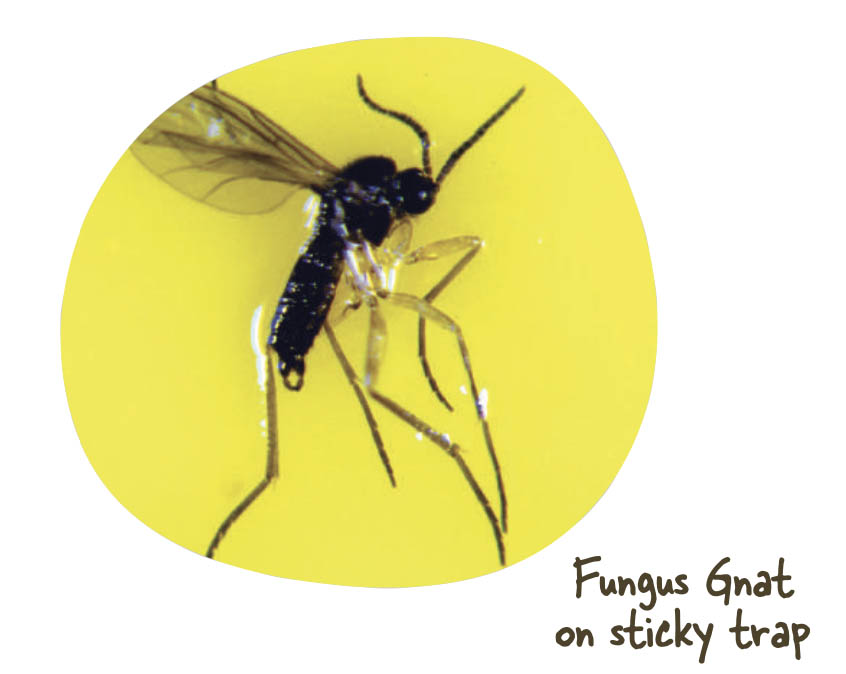
Symptoms
The flying adults do not cause damage to the plant, but they lay eggs in the growing media and are a nuisance. The larvae do feed on the roots, making the plant weak and slow-growing, which can eventually lead to harm for your plants.
Prevention
Do not reuse potting soil from year to year. Always use fresh, sterile potting mix when repotting plants. Use yellow sticky traps, which will attract and capture adult fungus gnats. This will not take care of the problem of fungus gnat larvae, but it will be an early warning sign of a problem.
Control
The most common way fungus gnats get into your garden is through soil of a purchased plant or the bag of potting soil you use. The first thing to do is to control soil moisture. Fungus gnats thrive in moist soil and can’t survive in dry soil. Apply insecticidal soap spray onto op your soil to kill gnats in potted plants. This is effective after a few applications. Lastly, you can replace the top inch of your soil with a fresh layer of potting soil, followed by a layer of sand. This will control the gnats in the soil and deter them from laying eggs.
Specific Tips for Fungus Gnats
Fungus gnats are attracted to wet soils that are high in organic matter and lay their eggs on the soil surface. In addition to the control advice here, you can use the tips below to battle your fungus gnat problem!
Let soil dry out for several days. Fungus gnat larvae live in the top few inches of soil. When the soil dries out, they will die. After that, ensure you are only watering into the bottom reservoirs of Earthbox/Growbox or that you let other contain- ers dry out between watering.
Replace top soil in container. If you still see an issue with fungus gnats in your garden, try remov- ing the top inch of soil from your containers. Replace this with fresh, clean potting mix.
Sand on the soil surface. Try spread a 1⁄2 inch layer of dry sand or diatomaceous earth over your soil to discourage eggs hatching.
Consider re-potting your plants. If you are still seeing a problem, try re-potting your plants if this is possible in your situation. Discard your infected soil, trim any infected areas of your plants and then re-pot.
Mealy bugs
Mealy Bugs
What they look like
Mealybugs are tiny white bugs on houseplants, and most commonly look like white fuzzy stuff on plants leaves and stems. Mealybugs can also appear brown or cream colored, and waxy in immature stages. At first glance they don’t look like insects and are commonly mistaken for fungus or mildew rather than plant bugs. If the white bugs you see on your houseplants look more like tiny white flies that fly around when the plant is disturbed, then those are whiteflies instead of mealybugs.
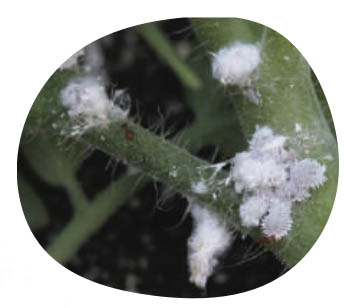
Symptoms
They are piercing-sucking insects, which feed on plant sap. The insects exude a honeydew, which can cause leaves to become sticky. Ants may be attracted to the sweet liquid. In time, a black mold, called sooty mold, can grow on the honeydew giving the leaves a dirty, sooty appearance. Plants infested with mealybugs become weak, may wilt and turn yellow, and eventually die.
Control
The first step is to quarantine your infected plant if you can. Remove as many mealy bugs as you can. You can also use a cotton swab soaked in rubbing alcohol and dab onto mealy-bugs. After that, you can use a soap spray to treat plants. Eggs of the mealybug hatch in about 2 weeks and young mature in 6-8 weeks, so ensure that repeated treatment is had.
Prevention
Inspect plants regularly. Ensure you check any plants coming indoors from outside.
Spider mites
Spider Mites
What they look like
Spider mites, at less than 1-mm long, are tiny relatives of spiders with eight legs and oval bodies. Spider mites look like grains of sand and are found mostly on the undersides of leaves. Eggs are round and clear and become a creamy color just before hatching. If you see white webbing, you most likely have an infestation.
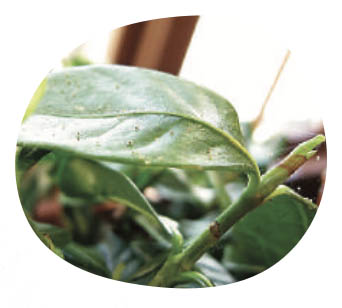
Symptoms
Spider mites mouth parts pierce and suck, causing damage by puncturing plant cells, resulting in fluid loss that eventually kills plants. An adult female can lay up to 20 eggs per day, causing infestations quickly.
Control
Isolate infested plants from others and spray them with a formula that kills the eggs and the larval stages as well as the adults. Use an insecticidal soap spray made from dish soap, water and vegetable oil. You will need to use two-three applications of soap spray. Once now, and once in 3 days and then 5-7 days to get the next generation.
Prevention
Spider mites often travel from garden to garden on nursery seedlings. Make sure to inspect any seedlings before planting in your garden.
Thrips
Thrips
What they look like
Thrips are hard to see at a mere 5-mm long. They can be yellow, brown or black. To the naked eye, they look like tiny threads.
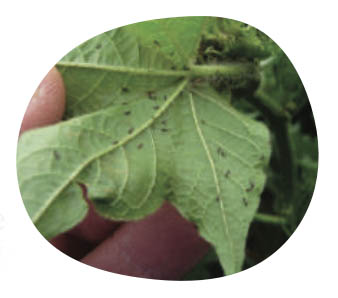
Symptoms
They leave fecal droppings on plants that appear as black spots. Females bore holes in leaves where they lay their eggs. If your garden is infested with thrips, leaves will eventually look dry—not wilted—and have yellowish spots. Look for silver or bronze colored streaks on leaves, which eventually turn brown, dry and crumbly. The pests feed by puncturing plants and sucking out the sap inside, creating the streaks.
Control
Remove any infected plants if you are able. Use an insecticidal soap spray made from water, dish-soap and vegetable oil. Repeat the treatment two to three times at 7- to 10-day intervals to ensure you've eliminated all of the pests and any new generations hatching.
Prevention
Check often for the presence of thrips by giving plants a gentle shake. The larva are wingless and will leap when jarred.
Whiteflies
Whiteflies
What they look like
Whiteflies resemble small, white moths and are about 1-mm long that cluster on the underside of leaves. The
nymphs are translucent and can appear to be the same color as the leaves. Like aphids, whiteflies secrete honeydew that is colonized by black sooty mold.

Symptoms
Look for stunted or twisted leaves, white spots or black moldy areas on the top of foliage. An adult’s mouth parts pierce and suck juices from plant leaves, causing white spots and yellowing. Females lay their eggs on the undersides of leaves.
Control
Trim or remove infested and damaged plants or leaves. You can also try vacuuming whiteflies. This is a quick and straightforward control for whiteflies at all stages of growth.
Be careful not to damage the plant. Simply use your handheld vacuum or vacuum cleaner's hose attachment to suck up whiteflies every few days. Make sure that any newly hatched whiteflies can't escape from your vacuum bag. Seal the bag when finished and leave in your freezer if available for 24 hour.
You can also use an insecticidal soap spray made from dish soap, water and vegetable oil. Be sure to target the pests on the bottom of leaves, too. Ensure that you apply the spray every 3 days for 9 days to stop future generations.
Prevention
Whiteflies are drawn to the color yellow, so set up yellow sticky traps. These will help capture whiteflies and help you monitor the pests. The traps alone can protect a few plants, but in larger indoor gardens they work best as an early warning system so you can notice an infestation before it spreads.


